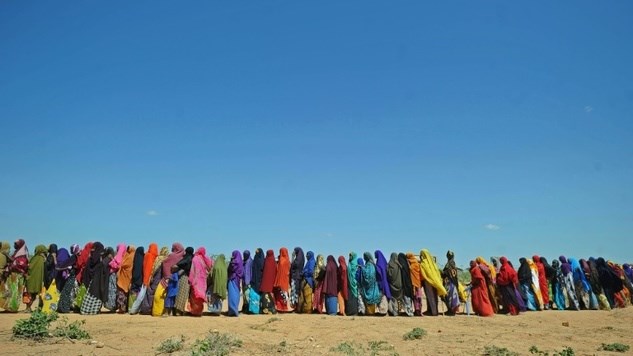
Hawa Nour,Petter Alingo
Monday September 26, 2016

Although representation discussions have led to good propositions, these are mere proposals, and their validity and authority remain doubtful given that real power continues to be held by traditional clan and religious leaders.
In May this year, Somalia’s President Hassan Sheikh Mohamud issued a decree legalising the presidential elections set to take place on 30 October, after the elections for the lower and upper houses of Parliament, which take place on 24 and 25 September.
The electoral process is based on the provisional constitution, which was adopted in 2012, and aims to ensure that the terms of the current president and Parliament are not extended. Although the current presidential term expired on 10 September, it seems an extension has been agreed upon up to the time of elections.
Universal suffrage – based on one vote for every voting-eligible man and woman – will not be used in the upcoming election. Rather, the so-called 4.5 clan-based formula will be used to determine the delegates who will vote for the lower House, while the regional states will select the members to the upper House. The collegiate system, which combines the traditional clan-based system and geographical voting, means that the process can be more accurately described as a selection, rather than an election process.
The constitution currently stipulates that women need to make up at least 30% of the seats in Parliament. There are no policies or laws in place to protect this quota, however, and the upcoming elections therefore place women’s representation at risk.
A number of National Leadership Forums (NLF) of Somali national and regional leaders took place earlier this year to determine modalities for the elections. The latest one was held in August in Mogadishu. Some of the issues discussed included the need to finalise the constitutional review process, and to establish political parties as a future alternative to the clan-based formula.
Integrating women in elections and public affairs was also part of the agenda, with traditional leaders and electoral colleges being urged to ensure that women comprise 30% of the delegates to elect the lower and upper houses.Each of the four main clans – the Hawiye, Darood, Dir and Rahanwein – were urged to ensure that they each had 18 female representatives, while the fifth clan – made up of a coalition of minority clans – should have nine. It was also proposed that clans’ nominations to the Upper House comprise 50% women. In addition, a 50% reduction of candidates’ fees for women was also recommended as an affirmative action initiative meant to break barriers for women and to encourage female candidates.
If these propositions were to be implemented, Somalia would have a commendable gender representation of about 81 women in Parliament. However, these are mere proposals, and their validity and authority remain doubtful given that real power continues to be held by traditional clan and religious leaders.
Although the provisional constitution allows for universal suffrage, implementing it has been hindered by failure to reach agreement on the election formula. Elites in Mogadishu favour the clan-based formula, which is advantageous to the current president – while the regional authorities support a district-based election formula, which favours the Darood clan in particular.
There are looming fears that even with a set date, the possibility of polls being delayed cannot be ruled out.To date, the 30% gender quota stipulated in the provisional constitution has not been realised. Women currently hold 39 out of the 275 parliamentary seats; a meagre 14%. This has largely been attributed to the lack of a mechanism to implement the quota system, combined with male-dominated traditional cultural norms.
This has been made worse by the excessive powers vested in the traditional leaders and religious scholars under the framework of the 4.5 clan formula – in which a group of elders elect members of the bicameral legislature at the National Constituent Assembly.
To be successful, candidates need to lobby for endorsement from not only the four main clans, but also the clan elders and religious scholars who wield immense traditional and cultural powers. It is during this process of lobbying that voter manipulation is bound to arise; including the side-lining of women.
The system has been criticised for its vulnerability, lack of transparency and lack of consideration for women and minority clans. Coupled with the need for viable institutions and a persistent failure to reach agreement on the rules of the game, it is easy to see how many factors work against the 30% gender quota.
Regardless of these challenges, Somali women remain optimistic and resilient. There is even a female presidential candidate, Fatumo Dayib, who has vowed to soldier on in the face of death threats and other challenges.
Fatumo even said she would enter into dialogue with al-Shabaab if elected. She is an example of how Somali women have played a significant role throughout their country’s history – even if in the background. Somali women have taken part in the various peace processes; from Arte in Djibouti to Mbagathi in Kenya, yet they continue to be victims of certain damaging cultural practices.
Women have particularly borne the brunt of the protracted conflict in the country, but continue to play a strong role as mothers, caregivers and protectors in their families.
Their resilience in the face of adversity makes them critical actors. Somali society should acknowledge this, and not allow women to be subjugated to the whims of clan and religious leaders.
Despite criticism, the election model to be used offers more diversity and inclusivity. The number of clan leaders who participate in the selection process has increased; along with greater inclusion of women, diaspora members and minority clans. This has created a sense of optimism about the upcoming elections, given the country’s long history of conflict and the general lack of democratic governance institutions and structures.
Achieving gender equity and equality remains a primary goal. The adoption of the national gender policy albeit with criticism from religious scholars, is a positive initiative. Public debate and awareness campaigns should be conducted to challenge negative traditional cultural narratives, and misinterpretation of Islamic teachings that lock women out of elective public and political leadership roles.
Given that the clan-based formula will be used in the October elections, there is a real risk that the constitutional 30% gender threshold might be undermined. Consolidating the constitutional gains for women in Somalia requires bold resolve to adopt enabling policies. President Mohamud ought to decree these in order to leave a legacy for the empowerment of Somali women. – ISS